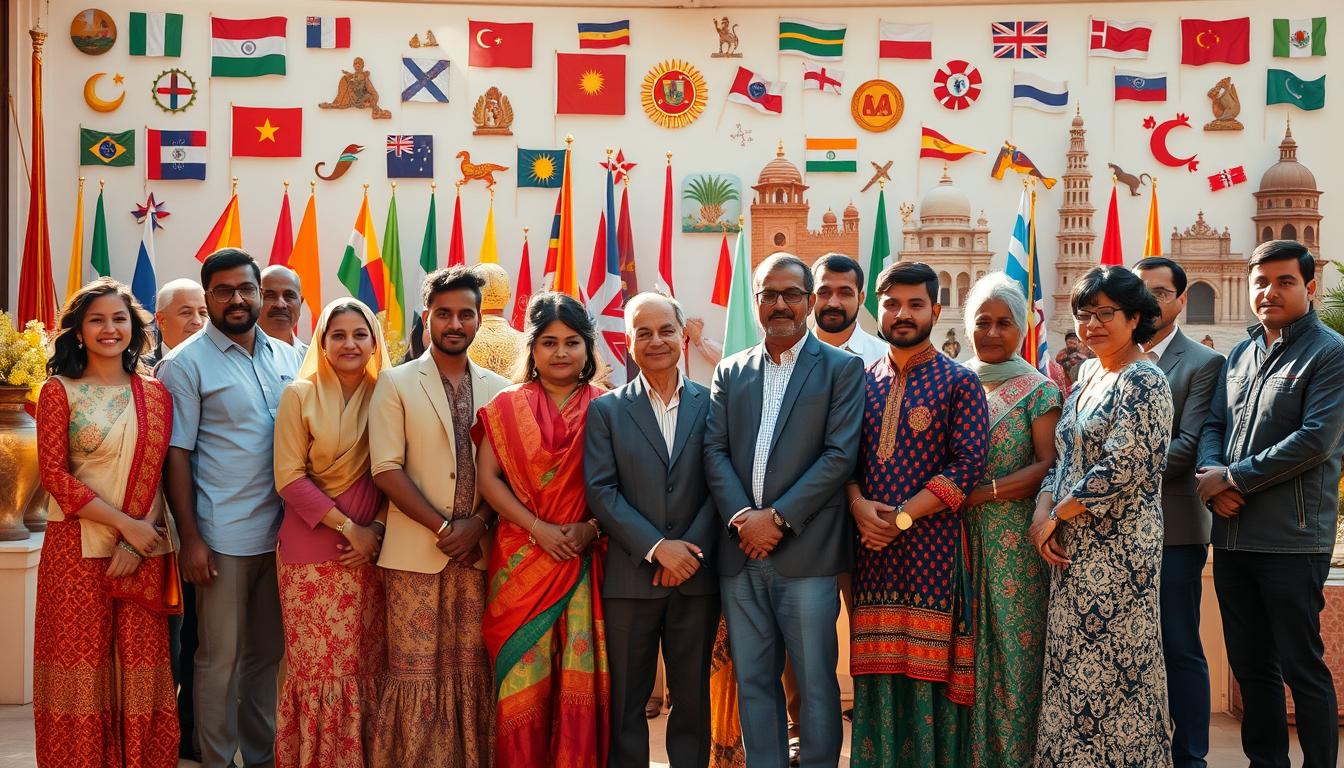Fostering Cross-Cultural Understanding: Global Exchange Initiatives
In today’s world, it’s more important than ever to understand different cultures. Global exchange programs offer a chance to learn and grow in diverse settings. They help us develop skills needed for working with people from all walks of life.
By joining these programs, we can close cultural divides. We learn to appreciate and respect the differences that make us unique. This is key in our multicultural world.
The Importance of Cross-Cultural Understanding
Cross-cultural understanding is key to better communication and relationships among different groups. It includes cultural awareness and sensitivity. People with these skills can move through complex social scenes with ease, understanding many cultural views.
Definition and Key Concepts
Cross-cultural understanding is about seeing and valuing the differences between cultures. It’s knowing the unique cultural norms and how they influence behavior and communication. Good intercultural communication comes from deep cultural knowledge, helping people connect across cultural lines.
Historical Context
The growth of cross-cultural understanding comes from big historical events. The rise of globalization and more people moving around have made diversity training more important. These changes have helped societies see diversity as a plus and work towards being more inclusive. This history lays the groundwork for today’s efforts in talking across cultures.
Benefits for Society
Building cross-cultural understanding brings many benefits to society. These include:
- Less stereotypes, which often cause misunderstandings.
- Stronger social bonds by valuing cultural differences.
- More teamwork on global issues.
By focusing on cultural awareness, communities can build harmonious places that celebrate diversity. This approach to intercultural communication makes interactions richer and strengthens bonds between people from different backgrounds.
Global Exchange Initiatives Overview
Global exchange initiatives are key in helping people understand different cultures. They offer chances to dive into new environments. This helps build a global mindset and boosts cultural competence.
By exploring various cultures, people gain the skills to move through our connected world. This is very important today.
What Are Global Exchange Initiatives?
These initiatives are programs that help people experience different cultures firsthand. They often involve traveling and meeting local communities. This leads to better understanding and teamwork between cultures.
People share ideas, traditions, and values. This broadens their views. It’s vital for doing well in our global society.
Types of Programs Available
- Student Exchanges: Programs that let students go to schools in other countries. They learn a lot academically and culturally.
- Volunteer Experiences: Ways for people to help out in local organizations. They help communities grow.
- Internships: Work chances in other countries. They improve career skills and introduce new cultures.
- Professional Exchanges: Programs for professionals to work together across borders. They grow their cultural understanding and professional networks.
Prominent Global Exchange Programs
Global Exchange Programs are key in building mutual understanding and cultural exchange. Many organizations run these programs, each making a unique impact. This section focuses on three standout programs and their missions.
United States Department of State Programs
The U.S. Department of State runs programs to improve cultural understanding. These efforts include educational and cultural exchanges. They help people see the world from different perspectives and build lasting connections.
Participants get to know various communities. This helps them grow their interpersonal skills while abroad.
Rotary International Initiatives
Rotary International is dedicated to peace and goodwill through its exchange programs. Participants dive into different cultures through these programs. They learn important skills through service projects and cultural workshops.
Rotary encourages community engagement. This helps participants grow and understand different cultures better.
Fulbright Program
The Fulbright Program is a leading academic exchange. It focuses on intercultural dialogue. By working together, U.S. and international scholars improve their skills and explore cultures.
The Fulbright experience often leads to lasting friendships. It also deepens appreciation for global diversity.
The Role of Education in Cross-Cultural Understanding
Education is key in building Cultural Awareness and promoting Global Education. Students learn a lot by exploring other cultures. This helps them appreciate different viewpoints.
Study abroad programs give students a chance to dive into new cultures. They grow both personally and academically.
Study Abroad Opportunities
Study Abroad Programs help students understand global citizenship. They offer:
- A chance to live in a different country and learn by doing.
- Opportunities to improve language skills through real-life interactions.
- Chances to make lasting friendships with people from different backgrounds.
These experiences help students develop empathy, respect, and cultural sensitivity. These are vital in today’s world.
Curriculum Development for Global Awareness
Schools can improve Global Education by adding global topics to the curriculum. A good curriculum might include:
- Courses on cultural history and social dynamics of different areas.
- Projects with international partners to broaden perspectives.
- Discussions on global issues and multiculturalism.
These steps help students understand cultural differences. They prepare for a future where inclusivity is key.
Community Engagement and Cross-Cultural Initiatives
Community engagement is key to understanding different cultures. Local events bring people together to share their traditions and stories. These meetings help build strong bonds and make our community richer.
Working with international groups adds more to these efforts. They bring new ideas and resources, helping us learn more about our shared values.
Local Cultural Exchange Events
Local events are vital in connecting different groups. They include:
- Workshops on traditional arts and crafts
- Culinary events with foods from around the world
- Festivals with music and dance from various cultures
- Discussion panels to break down stereotypes
These events help people talk and learn from each other. They make us appreciate our cultural diversity more.
Partnerships with International Organizations
Working with global groups is essential for community success. They bring expertise and resources to local projects. Some benefits are:
- Expert advice on cultural sensitivity
- Chances for community members to join global programs
- More funding for cultural activities
- Better promotion for local events
These partnerships help us celebrate our diversity. They offer learning experiences that go beyond our local area.
Challenges in Fostering Cross-Cultural Understanding
Trying to understand different cultures comes with big challenges. These challenges can make it hard to bring people together. Two big problems are language barriers and stereotypes.
Language Barriers
Language barriers can stop people from talking effectively. This leads to misunderstandings and wrong interpretations. When people from different cultures try to talk, not having a common language is a big problem.
This situation makes it hard for people to share their thoughts and feelings. It leads to feelings of frustration and being left out.
Stereotypes and Misconceptions
Stereotypes and cultural bias make understanding cultures harder. People might think they know others just because of their culture. These stereotypes and biases make it hard to have real conversations between cultures.
It’s important to break down these barriers to build strong relationships across cultures.
Best Practices for Successful Exchange Programs
Successful Exchange Programs need good planning and ongoing support. These steps help participants adapt to new cultures and keep learning after they return home.
Pre-Departure Training
It’s key to prepare participants before they go. Training should cover important topics like:
- Cultural Sensitivity: Knowing cultural norms helps with respectful interactions.
- Language Skills: Knowing some language makes daily life easier.
- Practical Matters: Learning about local customs and daily life makes the transition smoother.
Post-Program Support
Support after the program is vital. It helps participants keep learning. Good strategies include:
- Alumni Networks: Connecting former participants helps share experiences and resources.
- Reflection Workshops: Reflecting on experiences solidifies lessons and deepens understanding.
- Mentorship Programs: Pairing participants with future exchange-goers helps with the transition back home.
Measuring Impact of Cross-Cultural Programs
Measuring the success of cross-cultural programs needs a detailed approach. Organizations must look at both qualitative and quantitative data. This helps understand the real impact on participants and the community. By using strong Program Evaluation methods, groups can make sure these efforts have Measurable Impact and lead to good Cultural Outcomes.
Qualitative Assessment Methods
Qualitative methods are key to grasping participants’ personal stories. Interviews and focus groups help gather detailed data. This data shows the real effects of cultural exchanges.
Feedback from participants is vital for improving programs. They often share insights that show the program’s success or challenges. This helps understand how well the program boosts cultural understanding.
Quantitative Metrics
Quantitative metrics are crucial for showing clear results from cross-cultural programs. Surveys help measure how participants feel and what they learn. They look at things like satisfaction, knowledge, and confidence in working with different cultures.
By sharing these numbers, organizations can show the value of their programs. This helps keep support for cross-cultural efforts strong.
The Future of Cross-Cultural Understanding
As the world gets more connected, understanding between cultures is set to change a lot. Global trends make us rethink how we interact with each other. They show us the value of empathy and respect.
Thanks to digital communication, we have new ways to connect. This helps us bridge cultural gaps.
Trends in Globalization
Globalization brings different cultures together. It happens through trade, tourism, and work. This mixing of cultures leads to:
- More awareness of global issues.
- More cultural sharing through art, food, and entertainment.
- More diverse communities in local areas.
Technology’s Role in Facilitating Connections
Digital tools change how we connect across the globe. Social media, video calls, and online forums remove distance. They help us connect and understand each other better.
- Virtual exchange programs let students talk to peers worldwide.
- Collaborative projects improve cultural understanding among different groups.
- Podcasts, blogs, and webinars give us global views.
Case Studies of Effective Programs
Looking at successful exchange programs in the U.S. and abroad shows us what works. These examples teach us about the best ways to understand different cultures. They offer new ideas for future global learning projects.
Successful Models in the U.S.
In the U.S., many programs show how cross-cultural exchanges can succeed. Here are a few examples:
- The Youth Ambassadors Program: This program gives young leaders a month in the U.S. to learn about social and cultural issues.
- The American Field Service (AFS): AFS lets students study abroad, promoting cultural exchange and hosting.
- National Security Language Initiative for Youth (NSLI-Y): This program helps high school students improve their language skills and connect with new cultures.
Lessons Learned from International Examples
International programs also teach us valuable lessons. Key takeaways include:
- It’s important to have cultural orientation before and after arrival to keep participants engaged.
- Working with local communities can add depth and support to the experience.
- Using feedback helps programs improve and meet participant needs better.
Conclusion and Call to Action
Cultural engagement is more than just joining exchange programs. It’s about building bridges between different cultures. When we participate in exchanges, we help create a world that values understanding and connection.
By exploring different cultures, we gain new insights. This enriches our lives and strengthens our global community. It’s a step towards becoming better global citizens.
Encouraging Participation in Exchange Initiatives
It’s crucial to encourage people from all walks of life to join exchange programs. Schools, community groups, and businesses should promote these opportunities. This way, we can foster a culture that values diversity and acceptance.
When we engage with different cultures, we learn and grow together. This leads to deeper connections and a more united society. It’s a win for everyone involved.
Promoting Lifelong Learning on Cultural Understanding
In today’s fast-changing world, learning about cultures is essential. We should all strive to learn more about the world around us. This knowledge helps us understand and respect each other’s differences.
By making cultural learning a lifelong pursuit, we support a society that values understanding. This ensures that global citizenship remains a core value in our communities.
FAQ
What is cross-cultural understanding and why is it important?
How can individuals enhance their cultural competence?
What are global exchange initiatives?
What types of global exchange programs are available?
Why is community engagement crucial for cross-cultural understanding?
What challenges are faced in fostering cross-cultural understanding?
What are best practices for successful exchange programs?
How can the impact of cross-cultural programs be measured?
What future trends may affect cross-cultural understanding?
What can be learned from case studies of effective programs?
Published on: 5 de February de 2025

Luke Martin
Luke Martin, author of Credwallets.com, is a mathematics graduate with a specialization in financial markets. Known for his love of pets and his passion for sharing knowledge, Luke created the site to provide valuable insights into the complexities of the financial world. His approachable style and dedication to helping others make informed financial decisions make his work accessible to all, whether they're new to finance or seasoned investors.







